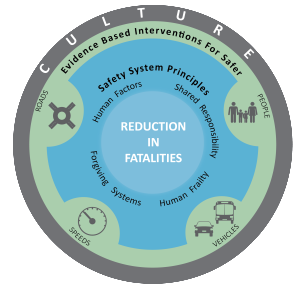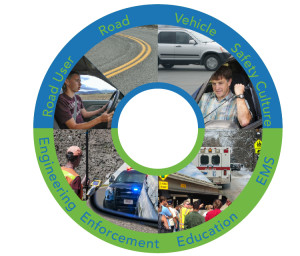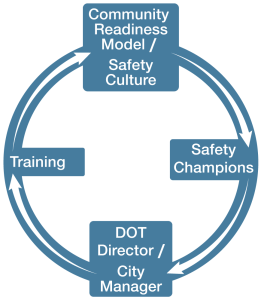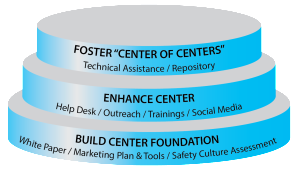Strategy
The National Center for Rural Road Safety (Safety Center) opened in December 2014. Funded by the Federal Highway Administration, this Center of Excellence is focused on enhancing safety on rural roadways by supporting local, state and tribal road owners and their stakeholders.
Vision

Mission

Our Approach to Enhancing Safety
The Center is unique in that the approach is holistic and multidisciplinary involving all the 4Es of safety :
- Engineering,
- Enforcement,
- Education, and
- Emergency Medical Services (EMS).
Another aspect of our holistic strategy is that we look at the many factors that affect safety and when they occur. This follows an approach known as Haddon’s matrix which focuses on four main factors:
- Road User,
- Road,
- Vehicle, and
- Safety Culture.
View the Safety Center Postcard
The Safety Center’s approach targets and tailors assistance to the people who need it. It is based on the “safe systems” perspective, which integrates best practices from traditional traffic safety models and emphasizes the importance of transforming the national road safety culture (RSC).

This cultural transformation is necessary to achieve sustainable traffic safety improvements by reducing risk behaviors and increasing acceptance of traffic safety initiatives. In other words, improvements have a widespread and long-term impact when safety is part of the culture – when everyone in the community values safe driving practices and expects it of themselves and others.
The Safety Center will also use the Community Readiness Model, to develop a traffic safety culture for organizations that requires the following:
- An agency Director integrating safety into every decision within a transportation agency.
- Safety champions who encourage the safety culture at every level of their organization.
- Multidisciplinary collaborations integrating safety across the 4Es through regular meetings of safety champions from different disciplines.
Safety Center’s Purpose and Strategies
The purpose of the center is to help rural road stakeholders implement safety strategies based on the holistic approach described above. Specific objectives include:
- Facilitate multi-disciplinary training
- Provide education and technical assistance
- Conduct research to close knowledge gaps
- Develop tools and methods for training and outreach
- Emphasize the importance of transforming the national roadway safety culture (RSC)
- Focus on integrated, multidisciplinary, and systemic approaches
The Safety Center’s Strategic Plan will carry out these objectives in three phases.
In the short-term, Phase 1 (our current phase) is building the center’s foundation. During this phase, we plan to:
- Establish a Safety Stakeholder Group
- Conduct a gap analysis
- Implement and market the center
- Develop outreach activities to foster awareness
In the medium-term, Phase 2 is to enhance the center. Our tasks will include:
- Create opportunities for accelerated knowledge transfer
- Engage the local level and allow customization, scale-ability and modularity
- Provide timely, responsive and on-demand technology transfer
- Create a center that is sustainable and nationally recognized
In the long-term, Phase 3 is to establish ourselves as a “Center of Centers,” in other words to make the Center the national focal point and centralized source for the most up-to-date research and information on rural road safety. Our planned tasks include:
- Foster continuous coordination and cooperation
- Contribute to the advancement, understanding, and use of rural surface transportation safety knowledge
- Create an environment of knowledge and information sharing






